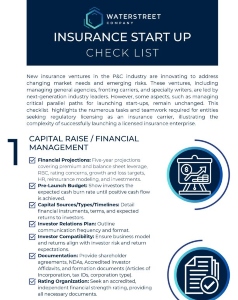It’s time for your startup to hit the ground running.
Once your startup has crossed the hurdle of raising capital and has navigated a maze of regulations, the real plans begin. The startup’s business model and product plan is the essence of the company. It’s time to capture the excitement behind why you’ve started this venture.
In this series, we outline each step of the process behind launching a P&C insurance startup:
- Capital Raise and Financial Management
- Regulatory Approval Process
- Operational Preparedness and Technology Choices
- Business Model, Plan and Product Model
- Competitive Environment
1. Prepare Your Business Plan
The first step when establishing your business model is to create a detailed business plan or Confidential Information Memorandum (CIM).
What is a CIM?
A CIM is a comprehensive document to cover every aspect of your new business, including your company’s vision, goals, target markets, distribution strategies, and financial projections. Investors and stakeholders will refer to this document to understand your growth strategy and assess the potential for profitability.
In your business plan, emphasize:
- How your startup’s product offerings differ from competitors
- Your risk management strategy
- How you plan to use technology to gain a competitive edge
Be transparent about your goals, whether it’s capturing a niche market or scaling to a broader customer base. Remember that your business plan is a living document and be prepared to adjust it as you refine your operations and receive market feedback.
2. Design Your Distribution Channels
An effective distribution strategy is vital for moving your insurance products into the hands of customers. Your choice of distribution channels can significantly impact the speed and efficiency of your market entry.
Consider the following options when designing your approach:
- Direct Distribution: Selling policies directly to consumers via online platforms, mobile apps, or call centers. This method is efficient and cost-effective, allowing you to control the entire customer experience from start to finish.
- Embedded Insurance: Embedding your insurance offerings within third-party platforms, such as mortgage or car sales websites. This approach can create a seamless purchase experience for customers and offer a new revenue stream through partnerships.
- Agent/Broker Distribution: Working with independent agents or brokers to sell your products is a common choice in the insurance industry. Agents bring their own customer relationships and local market knowledge, which can help you expand your reach quickly.
- Wholesalers: Partnering with wholesalers allows you to access large volumes of insurance buyers through their established networks of agents and brokers.
Outreach, Licensing, and Onboarding Plans
Consider how many producers you need, where they should be located, and how they can enhance your company’s exposure footprint.
- Outreach Plan: To establish a strong distribution network, your outreach should focus on regions where there is significant demand for your product offerings. Utilize industry data to pinpoint areas with market gaps, and tailor your outreach efforts accordingly.
- Licensing: Make sure your agents and brokers are properly licensed to sell insurance in each state or region where you plan to operate. Licensing requirements can vary, so it’s essential to have a process in place to ensure compliance.
- Onboarding: To onboard new agents and brokers efficiently, create an easy-to-follow process for educating them about your products and technology. This could include online training modules, in-person sessions, or a dedicated support team.
Compensation, Rollout Strategy, and Associations
- Compensation Structure: When designing your compensation structure for agents or partners, consider performance-based incentives that align with your business goals. Some companies opt for a commission-based model, while others include bonuses for achieving specific sales targets. The right structure will encourage your producers to stay motivated and help grow your customer base.
- Rollout Plan: Establish a phased rollout strategy for launching your products in different regions or with different agent groups. This staggered approach allows you to make adjustments based on initial performance and feedback from your distribution partners.
- Industry Associations: To establish credibility and stay connected to industry developments, join relevant insurance associations. Regularly attend events to keep your team informed on regulatory landscapes and to gain valuable networking opportunities.
3. Support Agents and Enhance Customer Service
Your distribution strategy must include a strong support system for both agents and customers. Excellent customer service will not only strengthen your brand but also increase loyalty among your agents and policyholders, enhancing vital retention rates.
WaterStreet Company & Insurance Startups
Here at WaterStreet Company, we support P&C insurance startups with next-generation, cloud-based insurance software. From Policy Administration and Underwriting to Claims and Accounting, we provide all elements of technology for your company to thrive.
Experience firsthand how WaterStreet’s cloud-based solutions can revolutionize your P&C insurance operations. Contact us today to request a consultation and demo.
Authored by Kelly King, CFO of WaterStreet Company





